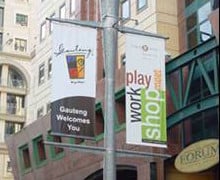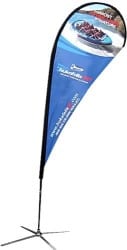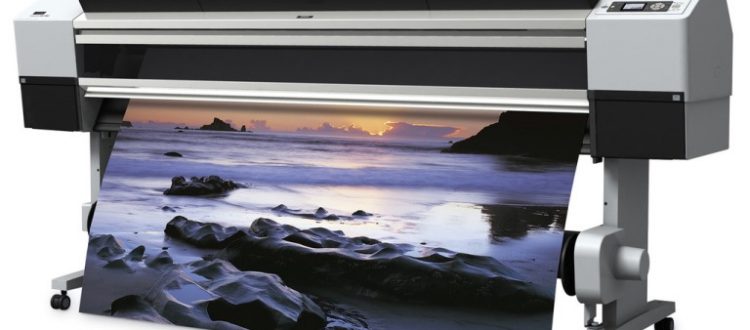The type of plastic and fabric materials printed on to make banner displays.
Question: What type of plastic are banners printed on?
Polyvinyl chloride, or PVC, is still one of the most popular materials to print banners with. There are other plastics as well, although one is a fabric type of plastic, but comes from petroleum as well.
Polyvinyl Chloride
 PVC is a petroleum-based plastic, as they all are, that has had “plasticizers” added to create the soft, roll-able material that many printers, screen, digital, and other printers have used for the past three decades.
PVC is a petroleum-based plastic, as they all are, that has had “plasticizers” added to create the soft, roll-able material that many printers, screen, digital, and other printers have used for the past three decades.
Polypropylene
Another plastic material that is used for really cheap promotions like at fast food chains and the like is polypropylene banner material. It is typically shiny and prints out very glossy and is used in both digital and screen printing prodigiously.
Polyester
Another polymer-based banner material is polyester, which is a woven fabric. It is the same type of material, with improvements, that your granddaddy used to wear suits made of. Like I said, though, improvements have been made to the materials so that now you can get anything from smooth poly knits to poly silks, poly flags, and sheer fabrics for almost any event, indoor or out.
 However, while polyester fabric banners are becoming more popular as prices come down, the printing process is much different for fabric or cloth banners. Dye sublimation printing, also alternatively knows as heat transfer printing, creates a long lasting and very attractive print on the various polyester fabrics that can last up to 30 years.
However, while polyester fabric banners are becoming more popular as prices come down, the printing process is much different for fabric or cloth banners. Dye sublimation printing, also alternatively knows as heat transfer printing, creates a long lasting and very attractive print on the various polyester fabrics that can last up to 30 years.
Standard Printing Methods
With PVC and “polypro” banners, the standard printing methods for screen printing or digital printing has remained the same for decades, and the material is very cheap, and the methods for printing have not changed dramatically for screen printing in many decades, and with digital printing for the past 15 years.
Banner Printing Pricing
PVC banners are now close to the same price as polyester cloth banners, and the latest method of dye sublimation printing, DTS/DTG (direct-to-substrate or direct-to-garment) has increased the speed of this process as well. Every time something improves technologically, the price will usually drop, although from my perspective, I doubt prices can decline much further, but I could be wrong. They could possibly, judging by low labor rates worldwide, possibly decline another 10 to 20%. For more about PVC or vinyl banners, see here.
Outsourcing Printed Banners
It is possible, with certain types of shipping, to purchase banners offshore, printed and shipped and delivered, at pricing lower than material and labor costs in developed nations in Europe, Canada, Australia, New Zealand, or the United States. I hate to be the bearer of bad news, but what is bad news for first world producers is good news for your marketing team. It costs less now to roll out a stunning retail campaign than it ever has in the past, and the graphics can be more stunning on fabric than has been possible ever in the past.
So, while the world economy is shifting, there are some good things happening that you can take advantage of, especially if you’re a marketing manager at a larger firm of any type, or an advertising agency buyer working with medium to large companies.
Popular Posts:




